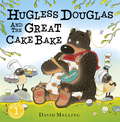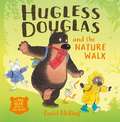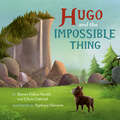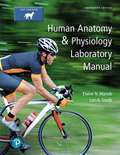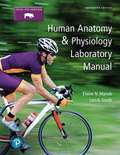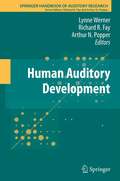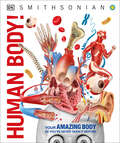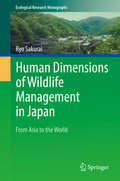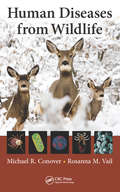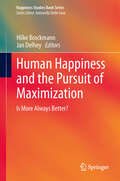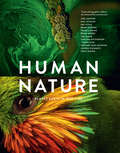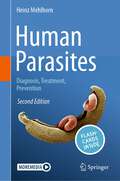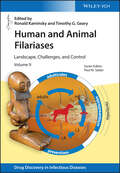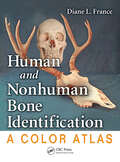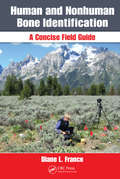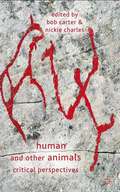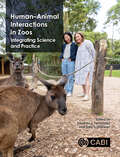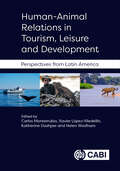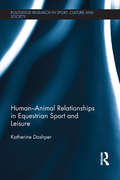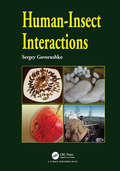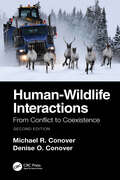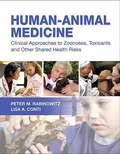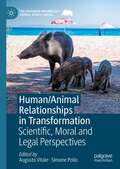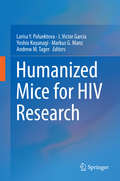- Table View
- List View
Hugless Douglas and the Great Cake Bake (Hugless Douglas #7)
by David MellingJoin Douglas on a honey hunt in the seventh Hugless Douglas adventure. This bestselling series has sold over 1.4 million copies to date in 26 languages!The sheep are baking honey cakes and Douglas can't wait to try them. He's sure that food without honey just isn't yummy. Can he ever be tempted to try something new?David Melling is one of the UK's best-loved author-illustrators and his seventh book about Douglas the brown bear is as funny and compelling as the first. It combines brilliantly imaginative illustrations with an endearing sense of what it is like to be a small child learning about the world.Hello, Hugless Douglas! was a World Book Day picture book in 2014. 'A new Hugless Douglas book is always a cause for celebration.' - Daily Mail
Hugless Douglas and the Nature Walk (Hugless Douglas #11)
by David MellingDouglas is very excited - he's off on a nature walk with all his friends from Little School.Miss Moo-Hoo has given everyone a worksheet with a list of interesting things to find - flowers, twigs, berries . . . and bugs. Soon everyone is too busy searching to notice that . . . DRIP, DROP . . . it's started to rain!Join Douglas and his friends for some fun in the great outdoors in this brand-new adventure! The Hugless Douglas series has sold over 1.9 million copies worldwide.'A new Hugless Douglas book is always a cause for celebration.' - Daily Mail
Hugo and the Impossible Thing
by Renée Felice Smith Chris GabrielHugo has one goal - to conquer the Impossible Thing.At the edge of the forest stood the Impossible Thing. All the animals in the forest often wondered what was beyond the Impossible Thing, but since everyone said getting through it would be impossible, no animal ever tried. Until a brave little dog named Hugo decides he just might be up to the challenge. With determination and some unexpected help from his friends, Hugo learns that what may seem impossible might just be possible after all.
Human Anatomy & Physiology Laboratory Manual: Cat Version
by Elaine N. Marieb R. N. Lori A. SmithHuman Anatomy & Physiology Laboratory Manual helps students and instructors manage time inside and outside of the A&P lab classroom and works hand-in-hand with Mastering A&P. The 13th Edition features dozens of new in the review sheets, as well as revamped clinical application questions and critical thinking questions. Encourage students to prepare for lab activities, including Building Vocabulary Coaching Activities, exercise review sheet assessment questions, art labeling activities, mobile-ready Practice Anatomy Lab(tm) 3.1 with customizable flashcards, and more.
Human Anatomy And Physiology Laboratory Manual, Fetal Pig Version
by Lori Smith Elaine MariebThe philosophy behind the revision of this manual mirrors that of all earlier editions. It reflects a still developing sensibility for the way teachers teach and students learn, informed by years of teaching the subject and by collecting suggestions from other instructors as well as from students enrolled in multifaceted healthcare programs. Human Anatomy & Physiology Laboratory Manual was originally developed to facilitate and enrich the laboratory experience for both teachers and students. This edition retains those same goals. This manual, intended for students in introductory human anatomy and physiology courses, presents a wide range of laboratory experiences for students concentrating in nursing, physical therapy, pharmacology, respiratory therapy, and exercise science, as well as biology and premedical programs. The manual's coverage is intentionally broad, allowing it to serve both one- and two-semester courses, and it is available in versions that contain detailed guidelines for dissecting a cat or fetal pig laboratory specimen.
Human Auditory Development
by Arthur N. Popper Richard R. Fay Lynne WernerThis volume will provide an important contemporary reference on hearing development and will lead to new ways of thinking about hearing in children and about remediation for children with hearing loss. Much of the material in this volume will document that a different model of hearing is needed to understand hearing during development. The book is expected to spur research in auditory development and in its application to pediatric audiology.
Human Body! (DK Knowledge Encyclopedias)
by DKExplore the human body as you&’ve never known before with this ultimate kid&’s guide to what goes on under our skin. Forming part of a fantastic series of kid's educational books, this bold and brilliant kid's encyclopedia uses ground-breaking CGI imagery to reveal the human body as you've never seen it before. Informative, diverse in subject matter, easy-to-read and brimming with beautiful graphics, young learners can explore the incredibly detailed cross-sections and cutaways that reveal the inner workings of these fascinating and complex machines we know as our bodies!This charming children&’s encyclopedia opens the world in new ways, with: - Packed with facts, charts, infographics and illustrations that cover the human body head to toe- Encompassing a visual approach with illustrations, photographs and extremely detailed 3D CGI images- Crystal clear text distills the key information.- DK's encyclopedias are fact-checked by subject experts to offer accuracy beyond online sources of information.This fully-updated edition of Knowledge Encyclopedia Human Body! is the perfect encyclopedia for children aged 9-12, ideal for inquisitive minds, with a unique head-to-toe approach that makes the complex structure of the human body both appealing and accessible for curious young readers. Jam-packed with fun facts about the human body, including creative CGI artworks that can be rotated and animated to bring the aspects of this body book to life! Curious children can take a look at the life of a cell, discover the digestive system, and learn all about record-breaking bodies!Explore, Discover And Learn!DK's Knowledge Encyclopedia Human Body! uncovers the marvels of our body in unprecedented detail and with stunning realism. Encompassing engaging facts about the human body, including a closer look at each bodily system, such as the nervous system, muscle system and more, and exploring a timeline of medical milestones, you can spend quality time exploring the wonders of the human body with children, accompanied by impressive visuals to engage their senses. A must-have volume for curious kids with a thirst for knowledge, this enthralling encyclopedia is structured in such a way that your child can read a bit at a time, and feel comfortable to pause and ask questions. Doubling up as the perfect gift for young readers, who are always asking questions about our planet! At DK, we believe in the power of discovery. This thrilling kid&’s encyclopedia is part of the Knowledge Encyclopedia educational series. Celebrate your child&’s curiosity as they complete the collection and discover diverse facts about the world around them. Dive into the deep blue with Knowledge Encyclopedia Ocean! Travel back in time to when dinosaurs roamed the earth with Knowledge Encyclopedia Dinosaur! And hone your knowledge on how the human body works with Knowledge Encyclopedia Human Body! Whatever topic takes their fancy, there&’s an encyclopedia for everyone!
Human Dimensions of Wildlife Management in Japan: From Asia to the World (Ecological Research Monographs)
by Ryo SakuraiThis book discusses the findings of research on the human dimensions of wildlife management conducted in Japan, demonstrating how such research and approaches have contributed to mitigating human-wildlife conflicts.Human-wildlife conflicts, including agricultural and property damage as well as occasional casualties, are a global problem for which local residents, managers, and stakeholders around the world are struggling to find solutions. Human dimensions of wildlife management (HDW) is an academic field developed in North America in the 1970s to gather information on the social aspects of human-wildlife issues to help wildlife managers and stakeholders implement effective decision-making measures. However, HDW is not widely recognized or applied outside North America, and few studies have investigated whether HDW approaches would be effective in different cultural settings.This is the first book written in English to introduce the HDW theories and practices implemented in Asia. Presenting innovative approaches and research techniques, as well as tips on how to introduce HDW methods into culturally different societies, it is a valuable resource not only for researchers and students in this field, but also for government officials/managers, NGOs, residents and other stakeholders who are affected by human-wildlife conflicts around the globe.
Human Dimensions of Wildlife Management in North America
by Daniel J. Decker Tommy L. Brown William F. SiemerThe term human dimensions covers a broad set of ideas and practices, including economic and social values, individual and group behavior, citizen involvement in planning and implementation of management, and communication.
Human Diseases from Wildlife
by Michael R. Conover Rosanna M. VailHuman Diseases from Wildlife presents information on the most prevalent and serious zoonotic diseases in the US and Canada, some of which have been national headline news like anthrax, influenza, and West Nile virus. Diseases that are caused by pathogens with the ability to infect both humans and animals are known as zoonotic diseases, which litera
Human Happiness and the Pursuit of Maximization: Is More Always Better?
by Hilke Brockmann Jan DelheyThis book tests the critical potential of happiness research to evaluate contemporary high-performance societies. These societies, defined as affluent capitalist societies, emphasize competition and success both institutionally and culturally. Growing affluence improves life in many ways, for a large number of people. We lead longer, safer, and more comfortable lives than previous generations. But we also live faster, and are competition-toughened, like top athletes. As a result, we suspect limits and detect downsides of our high-speed lives. The ubiquitous maximization principle opens up a systematic gateway to the pleasures and pains of contemporary life. Using happiness as a reference point, this book explores the philosophical and empirical limits of the maximization rule. It considers the answer to questions such as: Precisely, why did the idea of (economic) maximization gain so much ground in our Western way of thinking? When, and in which life domains, does maximization work, when does it fail? When do qualities and when do quantities matter? Does maximization yield a different (un)happiness dividend in different species, cultures, and societies?
Human Nature: Planet Earth In Our Time: Twelve Photographers Address the Future of the Environment
by Geoff Blackwell Ruth HobdayIn Human Nature, 12 of today's most influential nature and conservation photographers address the biggest environmental concerns of our time.• Joel Sartore• Paul Nicklen• Ami Vitale• Brent Stirton• Frans Lanting• Brian Skerry• Tim Laman• Cristina Mittermeier• J Henry Fair• Richard John Seymour• George Steinmetz• Steve WinterAlongside their reflections, they present curated selections from their photographic careers. Stories and extraordinary images from around the world come together in a powerful call to awareness and action.• The United Nations has declared that nature is in more trouble now than at any other time in human history.• Extinction looms over one million species of plants and animals.• Human Nature wrestles with challenging questions: What do we have? What do we stand to lose?This book offers inspiration to environmentalists, activists, photography fans, and anyone concerned about the future of our world.• This illuminating book tackles our modern environmental future through the lens of preeminent photographers• Great gift for photographers, nature enthusiasts, those who enjoy backpacking and camping, and anyone who cares about Earth's climate and future• Add it to the shelf with books like National Geographic The Photo Ark Vanishing: The World's Most Vulnerable Animals by Joel Sartore, The Sixth Extinction: An Unnatural History by Elizabeth Kolbert, and Dire Predictions: The Visual Guide to the Findings of the IPCC by Michael E. Mann and Lee R. Kump.
Human Parasites: Diagnosis, Treatment, Prevention
by Heinz MehlhornThe new edition of this textbook provides an up-to-date overview of the most important parasites in humans and their potential vectors. Climate change and globalization steadily favor the opportunities for parasites to thrive. These challenges call for the latest information on pathogen transmission routes and timely preventive measures.For each parasite, this book offers a concise summary in eleven sections:1. Naming2. Geographic distribution and epidemiology3. Morphology, biology and life cycle4. Disease symptoms5. Diagnosis6. Infection pathways7. Prophylaxis8. Incubation period9. Prepatency10. Patency11. Therapeutic optionsNumerous tables, diagrams and over 200 colorful illustrations highlight the main aspects of parasitic infestations and present suitable control measures. Moreover, 60 questions help to test readers’ theoretical knowledge of the field. Readers can additionally download the free Springer Nature Flashcards App and benefit from the digital study questions.In short, this work is highly recommended for anyone looking to delve into the field of human parasitology. It is intended for students of biology and human medicine, medical doctors, pharmacists and laboratory staff alike. Furthermore, persons who plan to visit or live longer in endemic regions will find essential information on necessary preventive and control measurements.
Human and Animal Filariases: Landscape, Challenges, and Control (Drug Discovery in Infectious Diseases)
by Paul M. SelzerHuman and Animal Filariases The rational approach to controlling human and animal diseases caused by nematodes Filariae are a family of parasitic worms which infect animals and humans, causing severe diseases such as elephantiasis (lymphatic filariasis) and river blindness (onchocerciasis) in humans, as well as heartworm disease (dirofilariasis) in dogs and cats. While the human diseases are rarely fatal, the blindness and disfiguration resulting from these infections constitute a severe burden for the affected individuals and to the healthcare systems in many tropical countries. In 2017, the World Health Organization classified several filariases as neglected tropical diseases and announced a new program seeking to eradicate these infections, which has in turn sparked a new push to develop antifilarial drugs. Considering the current and future import of this topic, Human and Animal Filariases takes a comprehensive look at infections by filarial parasites in humans and in animals. It begins by reviewing the current state of diagnosis and chemotherapy, before addressing the increasing resistance to available antifilarial drugs. This is followed by strategies and approaches for the discovery of novel drugs and finally by looking at alternative and supplementary approaches to combat the parasites, including vector control and vaccination. Human and Animal Filariases readers will find: A comprehensive approach that integrates current chemotherapy with recent advances in antifilarial drug discovery Practical information on assay development, target validation, and required drug product profiles Insights from global experts from leading academic institutions as well as from pharma and healthcare companies Human and Animal Filariases is a unique reference for parasitologists, veterinarians, as well as professionals in the pharmaceutical industry and in public health agencies.
Human and Nonhuman Bone Identification: A Color Atlas
by Diane L. FranceWhen a bone of unknown origin is found at a location, forensic implications arise immediately. Is this bone human, and if so, is it evidence of a murder? Human and Non-Human Bone Identification: A Color Atlas presents a comprehensive handbook of photographs and other information essential for law enforcement and forensic anthropologists when examin
Human and Nonhuman Bone Identification: A Concise Field Guide
by Diane L. FranceIn Human and Nonhuman Bone Identification: A Color Atlas,Diane L. France, one of the most respected forensic anthropologists in the world, offered a comprehensive handbook of photographs and other information essential for examining skeletal remains and determining species and body parts.Conveniently designed for field use, this compact version of
Human and Other Animals
by Bob CarterThis collection brings together a range of inter-disciplinary works which explore the questions raised by scientific practices and by different ways of conceptualizing the place of human beings in the material world. The contributors consider theoretical issues and the debate between those who advocate a post-humanist abandonment of any distinction between society and nature, human and animal, and those who argue for the importance of retaining these categorical distinctions. Through a range of case studies, they explore practices which reproduce and/or challenge the species barrier, including issues of animal rights and animal welfare, whether and under what circumstances animals are regarded as social actors with agency, media representations of human-animal relations, and the relation between animals and national identity. Taken together, these essays examine the social and political ramifications of different ways of theorizing and researching the relation between human and other animals.
Human-Animal Interactions in Zoos: Integrating Science and Practice
by Terry L. Maple Courtney Collins Amanda D. Webber Ellen Williams Geoff Hosey Vicky Melfi Sarah Webber Samantha J. Chiew Jon Coe Neil D’Cruze Angela J Dean Polly Doodson Lucy Dumbell Ashley N. Edes Kelly S Fielding Georgina Groves Lauren M. Hemsworth Paul H. Hemsworth Julia Hoy Violet Hunton Mark J. Learmonth Emily M McLeod Georgia Oaten Chris Pawson Bonnie M. Perdue David M. Powell Samantha WardHuman-Animal Interactions (HAI) are a primary welfare interest to both animal scientists and practitioners. In zoos and aquariums, the study of Animal-Visitor Interactions (AVI), including both the impact of visitors on animals (the visitor effect) and the impact of animals on visitors (the visitor experience), have become a focus for understanding HAIs in zoos. The study of HAIs in zoos has grown to consider a number of factors, including animal-staff interactions and bonds, modern exhibit design and technology, direct and indirect interactions, as well as positive and negative impacts on both animals and visitor alike. This thought-provoking book summarizes the latest research concerning the impacts of HAIs in zoos, including considerations for conducting research and managing HAIs. The book: Explores the interactions of animals with keepers, veterinary professionals, and other staff, and the effects of those interactions on the welfare of animals. Considers the impact of visitors on the well-being of animals. Covers the effects of interactions on education and the visitor experience. Outlines the use of technology to enhance experience, and improve animal welfare. Details theoretical, ethical, and practical considerations relevant to HAIs in zoos. An invaluable resource for animal behaviour and welfare scientists, students and practitioners, as well as anyone working with zoo animals.
Human-Animal Relations in Tourism, Leisure and Development: Perspectives from Latin America
by Katherine Dashper Carlos Monterrubio Xavier López-Medellín Helen WadhamHumans and animals have developed multiple and complex interactions in the fields of tourism, leisure, and development. However, much of the existing research on how humans and animals interact in these fields has emerged from within the context of developed countries. As a result, little has been documented about human-animal interactions in the socioeconomic, cultural, and environmental contexts of countries in the Global South. Specifically, the diversity and complexity of interspecies relationships in tourism, leisure, and local development in Latin America have been largely ignored in Anglo-Saxon literature. This has resulted in a limited, partial, and hegemonic understanding and debate about human-animal relationships globally, dominated by certain regions of the world. This book addresses this gap by documenting multiple and complex relationships between humans and animals in the fields of tourism, leisure, and local development in countries in Latin America. The book: Brings together empirical and conceptual works that reveal different disciplinary, theoretical, ethical, methodological, and practical perspectives. Reveals how human-animal relationships - both domestic and wild - can result in co-created interspecies experiences, conflicts, conservation efforts, welfare, and local development of human societies in the region. Equips stakeholders with conceptual frameworks and actionable tools to formulate policies that blend animal welfare and sustainability in Latin American tourism and recreation strategies. Challenges dominant narratives from the Global North regarding tourism and conservation, promoting a more inclusive and nuanced approach. This book will be of interest to researchers, professionals and policymakers within tourism, leisure, animal welfare, conservation and destination development.
Human-Animal Relationships in Equestrian Sport and Leisure (Routledge Research in Sport, Culture and Society)
by Katherine DashperRiding, training and caring for horses are visceral experiences that require the immersion of both body and mind. This book provides an in-depth understanding of human–horse relationships and interactions as embodied in equestrian sport and leisure. As a closely focused ethnographic study of the horse world, it explores the key themes of partnership and collaboration in human–horse communication, the formation of individual and collective identities performed through involvement in the horse world, and human–horse interaction as an embodied way of being. This book argues that encounters between humans and horses can reveal the ways that human society has been and continues to be structured through intersection with nonhuman others. Equestrian sport and leisure provides an apt context for considering how such concepts of interspecies communication and collaboration are negotiated, managed, (mis)understood and performed, resulting in a uniquely embodied way of knowing and being in the world. Human–Animal Relationships in Equestrian Sport and Leisure is fascinating reading for anyone interested in equestrianism, human-animal studies, theories of embodiment, the sociology of sport, or sport and social theory.
Human-Insect Interactions
by Sergey GovorushkoThis book presents a 360-degree picture of the world of insects and explores how their existence affects our lives: the "good, bad, and ugly" aspects of their interactions with humankind. It provides a lucid introductory text for beginning undergraduate students in the life sciences, particularly those pursuing beginner courses in entomology, agriculture, and botany.
Human-Wildlife Interactions: From Conflict to Coexistence
by Michael R. Conover Denise O. ConoverThis book won the 2023 The Wildlife Society Publication Award in the authored book category. Human-wildlife interactions increase exponentially as more and more humans and wildlife crowd into the same limited space. Such interactions often become conflicts when wildlife threaten human health and safety, well-being, or the food supply. This second edition of Human-Wildlife Interactions: From Conflict to Coexistence provides a comprehensive review of the severity of these problems and the methods used to resolve clashes between humans and wildlife. During his forty-year career as a wildlife professor and scientist, Dr. Michael Conover, founder of journal Human-Wildlife Interactions, has become a recognized leader of the scientific field of human-wildlife interactions. In this book, he presents the range of methods for wildlife damage management, including employing lethal methods; distributing supplemental food; changing the behavior of either humans or wildlife; and excluding or repelling wildlife. Backed by numerous case studies and informative side bars, the book documents resolutions to specific human-wildlife conflicts throughout the literature. Containing full color illustrations throughout, the second edition of Human-Wildlife Interactions: From Conflict to Coexistence provides authoritative coverage and depth of both theoretical and practical information. It serves as an invaluable resource for students, researchers, and professional wildlife managers. Disclaimer: Figure 7.7 (b) on page 251 was incorrectly attributed in previous printings. The photographer of figure 7.7 (b) is Cynthia Herrick.
Human-animal Medicine: Clinical Approaches To Zoonoses, Toxicants And Other Shared Health Risks
by Lisa Conti Peter RabinowitzHuman-Animal Medicine is an innovative reference exploring the unprecedented convergence of human, animal, and environmental health, triggering global pandemics and requiring new clinical paradigms. The "One Health" approach calls for greater communication and cooperation between human health care providers, public health professionals, and veterinarians to better address vital issues of emerging diseases and environmental change. This incredibly timely book provides, for the first time, practical guidelines for "One Health" collaborations in a wide range of clinical human-animal health issues, including the H1N1 virus, zoonotic diseases, the human-animal bond, animal allergy, bites and stings, and animals as "sentinels" for toxic environmental health hazards.
Human/Animal Relationships in Transformation: Scientific, Moral and Legal Perspectives (The Palgrave Macmillan Animal Ethics Series)
by Augusto Vitale Simone PolloThe ethics of human/animal relationships is a growing field of academic research and a topic for public discussion and regulatory interventions from law-makers, governments and private institutions. Human/animal relationships are in transformation and understanding the nature of this process is crucial for all those who believe that the enlargement of moral and legal recognition to nonhuman animals is part of contemporary moral and political progress. Understanding the nature of this process means analysing and critically discussing the philosophical, scientific and legal concepts and arguments embedded in it. This book contributes to the discussion by bringing together the ideas and reflections of leading experts from different disciplinary backgrounds and with a range of scientific perspectives.This book both provides an up-to-date examination of the transformation of human/animal relationships and presents ideas to foster this process.
Humanized Mice for HIV Research
by Larisa Y. Poluektova J. Victor Garcia Yoshio Koyanagi Markus G. Manz Andrew M. TagerOver the last several years the field of humanized mice has matured and developed into an essential component of translational research for HIV/AIDS. Humanized mice serve both as vehicles for discovery and as highly sophisticated platforms for biomedical research. In addition, humanized mice have demonstrated outstanding potential for the investigation of critical aspects of the infection and pathogenesis of the hepatitis and herpes viruses, as well as highly relevant microbial infections such as tuberculosis and malaria. Humanized Mice for HIV Research provides a comprehensive presentation of the history, evolution, applications, and current state of the art of this unique animal model. An expansion of twelve review articles that were published in Humanized Mice by Springer in 2008 (Eds: Nomura T, Watanabe T, Habu S), this book expertly captures the outstanding progress that has been made in the development, improvement, implementation, and validation of humanized mouse models. The first two parts of this book cover the basics of human-to-mouse xenotransplantation biology, and provide critical information about human immune cell development and function based on individual models created from different immunodeficient strains of mice. The third and fourth parts investigate HIV-1 biology, including different routes of transmission, prevention, treatment, pathogenesis, and the development of adaptive immunity in humanized mice. The fifth part shows the broad applicability of humanized mice for therapeutic development, from long-acting antiretroviral combinations to genetic manipulations with human cells and cell-based approaches. The sixth part includes liver tissue engineering and the expansion of humanized mice for many other human cell-tropic pathogens.
